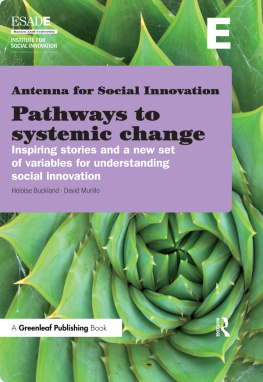First published 2013 by Greenleaf Publishing Limited
Published 2017 by Routledge
2 Park Square, Milton Park, Abingdon, Oxon OX14 4RN
711 Third Avenue, New York, NY 10017, USA
Routledge is an imprint of the Taylor & Francis Group, an informa business
Copyright Heloise Buckland and David Murillo
February 2013
All rights reserved. No part of this book may be reprinted or reproduced or utilised in any form or by any electronic, mechanical, or other means, now known or hereafter invented, including photocopying and recording, or in any information storage or retrieval system, without permission in writing from the publishers.
Notice:
Product or corporate names may be trademarks or registered trademarks, and are used only for identification and explanation without intent to infringe.
Design: www.cosmic.es
Cover photo: Alexis Urusoff and Brewbooks
British Library Cataloguing in Publication Data:
A catalogue record for this book is available from the British Library.
ISBN: 978-1-78353-053-3 (pbk)

Preface and introduction
This book has been inspired by a desire to deepen our understanding of social innovation and its role in addressing todays most pressing social, economic and environmental challenges. The growing movement of what can be succinctly described as new ideas that solve social problems is evolving at an unforeseen pace and we are witnessing an unprecedented increase in the volume of social innovations as well as the types of approach taken. In this book we begin by defining a series of variables to help analyse how, when and why social innovation can be most effective. Then, using these variables we go on to analyse four inspiring examples of social innovation. Drawing on this analysis, we conclude by offering some reflections and insights on the key parameters that help identify those social innovations that have the potential to bring about the much needed systemic change to resolve todays challenges.
Building on a track record of research and education in corporate social responsibility and social entrepreneurship in 2011 the Institute of Social Innovation launched the Antenna for Social Innovation with the publication of a report which set out to inspire and raise awareness about the potential for social innovation and to identify global trends and changes in this evolving sector. The broad overview offered by this initial report was accompanied by critical reflections on core debates concerning, firstly, the definitions and characteristics of social innovation, and, secondly, the challenges faced by social entrepreneurs and the social contexts in which they operate. In this first report we used social innovation as an overarching term to encompass social entrepreneurship, social enterprise, philanthropy and a series of different, primarily private, initiatives that work towards bringing solutions to pressing social problems.
Ten inspiring social innovations from around the world were highlighted in the first report which concluded that the sector is gaining momentum. Indeed, this is evident from the sheer volume of initiatives, from grassroots community projects and innovative private initiatives to paradigm-shifting regional and global networks for change. Furthermore, the increasing prominence of what have become known as Innovation HUBS also reflects a growing interest in stimulating and supporting these innovations. These HUBS, which provide emerging support systems for social entrepreneurs and new innovations, include academic centres, organisations and foundations, governments and international sharing platforms.
Building on our understanding of some of the key characteristics and challenges faced by social entrepreneurs, in this years report we present five key variables to enable a deeper analysis of social innovation. These variables cover a range of aspects including the level of social transformation achieved, the strategies deployed to work across sectors and boundaries, financial stability and viability, the types of innovation adopted and finally, the potential to scale or replicate initiatives.
We have selected four remarkable initiatives each operating at a very different scale (urban, regional, national and international) and their stories are explored through the lens of five variables. While each case is an inspiring example of social innovation in itself, considering them all as a group contributes to a deeper understanding of how best to measure social innovation and identify future challenges and success factors.
Our selection of case studies and variables is by no means random. Through the analysis of these cases we are convinced that we can all learn from the globalised and open environment in which social innovation operates. Furthermore, the relationship between global and local initiatives is bi-directional: we learn from what is happening beyond our political borders by incorporating, translating and adapting what functions well far from here, while also sharing via the internet, through publications, reports and case studies what we have learned about social innovation, thereby transferring it to the global sphere.
In terms of the chosen variables each is significant. To begin with, we should declare our point of departure: there is no one definition of social innovation, nor will there ever be. The debate concerning the precision of terminology may be of interest to academics and experts, but when we engage with practitioners, who may potentially be interested in this type of publication, such debates are at best of secondary interest. What interests us is what each of us understands by social innovation, and above all, according to what variables can we think about it, analyse it and transmit it.
Our selection is based on what we understand as the pressing issues affecting our immediate context. We are in need of tried-and-tested initiatives that function: that is to say, which provide some type of measurable (local or global) social impact, and which are efficient and results oriented. Therefore, they must be initiatives that are willing to cross sectors and management styles (public, private, non-profit) and to take from each of these spheres whatever they can benefit. Furthermore they must be open initiatives, replicable and at least to a certain degree scalable. In other words they should be transferable: ones that we can teach about, share and learn from the analysis of their way of working in a way that goes beyond their local and specific reality. Finally, and of special relevance for the present economic climate, they have to be self-sufficient initiatives, independent of the pull of the public sector and in their use of public funding.
A final point regarding how to read this book: fans of the writing of Julio Cortzar will recall the introduction to Rayuela (1963) and the different itineraries the author designed for the reading of his work. There are also different ways to engage with the content of this book. We would like to propose three:
A. Those interested in gaining an understanding of what social innovation is in practice can go directly to the books third section, which is devoted to the four case studies. They can choose the case study that interests them on the basis of the profile of its instigators (NGO, government or civil society) or the projects scope (global, national, regional or local). A brief reading of the introduction of each case study should suffice for the reader to understand the central characteristics of each one prior to immersing themselves in the transversal analysis of the different variables undertaken for each case study.











